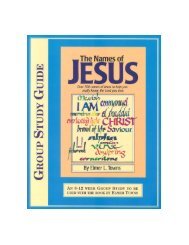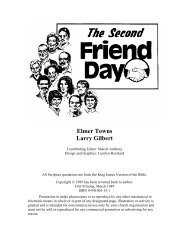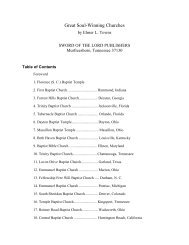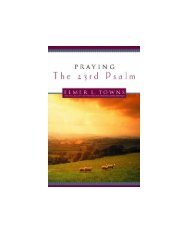PUTTING AN END TO WORSHIP WARS - Elmer Towns
PUTTING AN END TO WORSHIP WARS - Elmer Towns
PUTTING AN END TO WORSHIP WARS - Elmer Towns
- TAGS
- worship
- elmer
- towns
- elmertowns.com
Create successful ePaper yourself
Turn your PDF publications into a flip-book with our unique Google optimized e-Paper software.
strengths of this worship style into their ministries. This can be done by many evangelical<br />
churches in two areas. First, we can learn to appreciate the rich worship traditions of other era<br />
and cultures as a part of our contemporary worship of God. Second, we can learn from the<br />
Liturgical Churches to develop unique ministries that meet the felt needs of people in our<br />
community.<br />
There are various ways in which traditional worship expressions can be incorporated into<br />
church worship services. Some pastors have incorporated the recitation or reading of a creed<br />
such as the Apostle's Creed into their worship services on a short term basis during a preaching<br />
series on that creed. A similar approach has been used incorporating praying the Lord's Prayer<br />
into a church service during a preaching series on that topic. Also, many pastors of non-liturgical<br />
churches have opted to incorporate a Pauline blessing or one of the other blessings of Scripture<br />
into their benediction. Perhaps the most common season for incorporating aspects of the<br />
Liturgical Church approach to worship into other worship styles is the Christmas season. The<br />
use of carols represents a music style more common to another era than that of contemporary<br />
worshippers.<br />
The example of Christmas demonstrates that non-liturgical church members can find rich<br />
meaning in liturgical worship styles. The wise worship planner will periodically look for hymns,<br />
carols and choruses written in other cultures and times to add variety to the church's worship<br />
experience. When used appropriately and blended with the usual worship style of the<br />
congregation, the total worship experience can be more meaningful. A common example of this<br />
practice is seen in the use of a fifth century Latin hymn, Adeste Fideles (O Come Let Us Adore<br />
Him), which is often sung as part of a series of choruses in many renewal congregations. Some<br />
in those congregations might argue the singing of Latin hymns would hinder worship not<br />
realizing that they themselves have used such a hymn to express their own desire to worship<br />
God.<br />
A second strength of the Liturgical Church which can be adopted by other worship styles<br />
is the expression of worship in service to others. Many churches have done this to some degree<br />
with special collections of food and/or gifts for the poor at Thanksgiving or Christmas. More<br />
significant ministries to address social needs in the community can also be developed by<br />
churches willing to invest the time and effort required.<br />
Churches interested in making a significant impact on their community usually begin by<br />
investigating the unique needs of their community. Many city planning departments compile<br />
information on various neighborhoods within the city. This demographic information is usually<br />
available to business and community groups upon request. Other churches conduct community<br />
surveys to identify the felt needs of the community in which the church is located. As a result of<br />
this approach, many churches have become involved in providing a Day Care ministry or after<br />
school care within their church facilities. While these ministries involve a major financial<br />
investment, other ministries may be developed with little or no cost to the church. Many<br />
churches have used their facilities for a coffee-house/drop-in center or to conduct a midnight<br />
basketball league in an effort to help youth avoid involvement in drugs or crime. Others have<br />
developed special summer ministries such as Vacation Bible School or camps to assist parents in
















